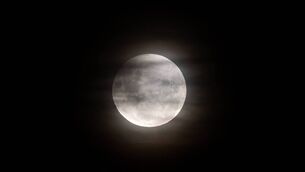Fulsome fulmar a highlight of bird fest
He arrived at our door, binoculars slung around his neck, four hours after landing at Cork Airport, only an hour away in his rented car.
Heading west via Kinsale, he first visited the Old Head — rather, the public carpark in front of the golf club gates which is as far as non-golf club members can go — and enjoyed the exhilarating sights of fulmars cruising past him as he sat on the cliff top in the autumn sun and fresh Atlantic air.
Next, reaching the sea at Kilbrittain Creek on the north side of Courtmacsherry Bay, and turning left to follow the seaside road around the long circuit to the south side, he was arrested by the sight of a small flock of bartailed godwit on the narrow strip just above the tide. Among them were blacktailed godwit, redshank, oysteratchers and a few grey plover.
There were widgeon and teal and, yes, a little egret in the shallows. ! And then, he remembered the little egret has become quite common around the bay. He stopped again at Timoleague Abbey, where the birds were densely packed along the marsh edges and he could view the flocks in the yellow sunlight, noticing that the breasts of some godwit were still vaguely red, a sort of faded pink, the last vestiges of their brilliant, brick-red breeding plumage.
For a birdwatcher, the circuit of Courtmacsherry Bay (16km of road, running alongside coastal flats, salt marsh and estuary) is sure to be full of stops, starts and mounting excitement, especially from September to May, when the tide is full in and the migrants have arrived in their tens of thousands. For twitchers, there’s always the chance of adding previously ‘un-twitched’ vagrant trans-Atlantic birds such as American widgeon or spotted sandpiper, Bonaparte, Iceland or ring-billed gulls. The bay is a twitcher’s delight, and so our friend turned up four hours after leaving the airport, chattering about the wonderful birds he’d seen en route.
We, who live alongside it, also greatly enjoy the bay and the cliff walk where it turns south beyond the bay mouth, called The Point of the Wood, and there are no more houses and usually nobody but oneself on the cliff fields of The Seven Heads Walk.
Each time I walk along the path above the narrow cove where I last saw our dog, Nicky, I look down into it and realise how steep are the sides and how long a fall it is to the rocks. No human could have survived such a fall and it becomes clearer that Nicky, having misjudged the edge and gone over, must have met an instant death on the rocks before being washed out to sea.
It is a lonely place, the cove of Coomalacha, nothing but the sea and the ravens that haunt the place and nest there, the gulls, a pair of stonechats that live in the briars and stunted blackthorns, sculpted by the south-westerlies into apocalyptic shapes.
The blackberries in the ditch are sweet; it is the realm of the wind, the sun and the sea. On the fence wires, an orb spider is spinning a cocoon of silk around a captured prey.
It is now five months since Nicky vanished. We can no longer have any doubt as to her fate but I am still puzzled by her missing collar. On the body, perfect in every way, showing no wounds or damage, the collar was missing. It was hardly the kind of collar anyone would steal, a strong, old leather band with a simple buckle.
How it could have come off in the sea is beyond me. Did some sea creature take it? What creature? A cruising shark, nipping at her floating body, then catching the collar in its teeth and deciding not to bother? It is a mystery of the sea. It is unfathomable, one might say.












